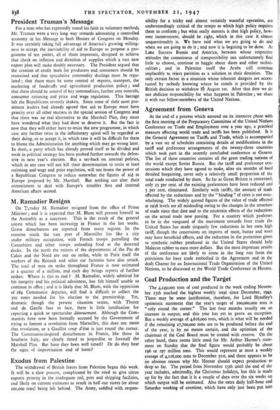Agreement from Geneva
At the end of a process which entered on its intensive phase with the first meeting of the Preparatory Committee of the United Nations Conference on Trade and Employment over a year ago, a practical measure affecting world trade and tariffs has been published. It is the General Agreement on Tariffs and Trade, which is accompanied by a vast set of schedules containing details of modifications in the tariff and preference arrangements of the twenty-three countries which took part in the recently concluded conference at Geneva. The list of these countries contains all the great trading nations of the world except Soviet Russia. But the tariff and preference con- cessions which they have agreed to make, after six months of hard detailed bargaining, cover only a relatively small proportion of the total trade conducted by them. So far as Great Britain is concerned, only 25 per cent. of the existing preferences have been reduced and 5 per cent. eliminated. Similarly with tariffs, the amount of trade affected by the reductions and by the " binding " of rates is not over- whelming. The widely quoted figures of the value of trade affected at 1938 levels are all misleading owing to the changes in the structure of trade since that date and to the uncertain effects of the reductions on the actual trade now passing. For a country which professes to be in the vanguard of the movement towards freer trade the United States has made singuarly few reductions in her own high tariff, though the concessions on imports of meat, butter and wool may have beneficial effects, and the reduction in the protection given to synthetic rubber produced in the United States should help Malayan rubber to earn more dollars. But the most important results of the conference are likely to come in the long run from the provisions for freer trade embodied in the Agreement and in the draft Charter for an International Trade Organisation of the United Nations, to be discussed at the World Trade Conference in Havana.


































 Previous page
Previous page